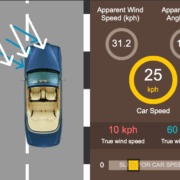LEARN SAIL TRIM
Learn more about sail trim with either NauticEd’s FREE Basic Sail Trim Course for any aspiring sailor, or learn more comprehensive techniques with the Advanced Sail Trim online course.
Mainsail Trimming – Traveler vs Mainsheet?
Using the Traveler and Mainsheet Together
Remember that the headsail “feeds” wind to the mainsail. Thus it is important to do the head sail first. Once the headsail is trimmed, then adjust the mainsail so that all its telltales are streaming back.
Trim the headsail by first adjusting the jib sheet to get the lower telltales streaming back then adjust the jib fairlead car forward or back to get the upper telltales streaming back.
Trimming the Headsail
- If the upper inner (windward) telltales on the head sail are fluttering they need more laminar flowing wind over them. Thus the upper section of the headsail needs to move inward (towards the centerline of the boat). To do this, move the fairlead car forward – this tightens the leech (the aft) of the sail which brings the upper area of the sail in.
- Conversely, if the upper outer telltales on the head sail are fluttering they need more laminar flowing wind over them. Thus the upper section of the headsail needs to ease out to leeward (away from the centerline of the boat). To do this, move the fairlead car aft – this loosens the leech of the sail which moves the upper area of the sail outwards allowing wind to flow smoothly around the outer side of the headsail.
See the animation here where the top of the sail is closed to windward as you move the fairlead car forward. Moving the fairlead car aft “opens” to the top of the sail and moves the top section of the sail to windward.
Once the headsail is trimmed well, move to trim the mainsail.
Trimming the Mainsail
The traveler and the mainsheet work dynamically together. Both move the boom inwards and outwards from the centerline of the boat. The difference is that the mainsheet also lets the aft of the boom move up and down and thus loosening or tightening the leech (aft) of the sail. Thus they both need to be finessed together to achieve mainsail efficiency. This efficiency and the set of the mainsail depends largely on the wind strength at the moment.
See this animation that shows the differences in moving the traveler and the mainsheet. Pay attention to the shape of the sail at the top section each time you move the traveler or the mainsheet.
For initial visualization, assume the boat is on a close haul
- Adjust the traveler’s position to the centerline of the boat
- Trim the mainsheet so the lower telltales are streaming aft
- Observe the upper telltales
- If they are all streaming back, you’re nicely trimmed
- If they are fluttering on the leeward side of the sail, you need to move the upper section of the mainsail to leeward – ease the mainsheet. This allows the boom to rise a little and twist out the top of the sail so that the wind can flow smoothly on the leeward side (while maintaining flow also on the windward side). If the lower telltales begin to flutter on the windward side as a result of easing the boom outwards, you can move the traveler to windward to re-trim the lower section of the sail.
- If they are fluttering on the windward side, you need to move the upper section of the mainsail to windward – tighten the mainsheet. This will bring down the boom and consequently tighten the leech – and flatten the upper area of the sail – moving it inward to the centerline of the boat. If the lower telltales begin to flutter on the leeward side as a result, you can move the traveler to leeward to re-trim the lower section of the sail.
Telltales on the mainsail are typically mounted on the sail as well as at the leech (back) of the sail. If you don’t have them, by all means add them. Pay attention to the luff (the forward area of the sail next to the mast), the luff should not be folding in on itself. However, see the reefing section where you might consider allowing this forward luff fold a little in higher winds prior to reefing.
When the mainsail trim is right, the top batten is approximately parallel with the boom angle or out a little, and telltales fly evenly inside and outside. The sail is trimmed properly when telltales from top to bottom stream aft; now to make it hold a course.
For trimming at angles to the wind other than close haul repeat the above. Many times it is easier to start with the traveler centered and mainsheet adjusted for lower telltale then incrementally trim both traveler and mainsheet.
3D Visualization
View this video below to see the mainsail changing shape with our 3D visualization animation.
LEARN SAIL TRIM
Learn more about sail trim with either NauticEd’s FREE Basic Sail Trim Course for any aspiring sailor, or learn more comprehensive techniques with the Advanced Sail Trim online course.








